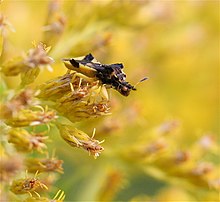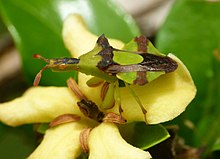| Phymatinae | |
|---|---|

| |
| Phymata sp. | |
| Scientific classification | |
| Domain: | Eukaryota |
| Kingdom: | Animalia |
| Phylum: | Arthropoda |
| Class: | Insecta |
| Order: | Hemiptera |
| Suborder: | Heteroptera |
| Family: | Reduviidae |
| Subfamily: | Phymatinae Laporte, 1832 |
| Tribes | |

Insects in the subfamily Phymatinae are commonly called ambush bugs after their habit of lying in wait for prey, relying on their superb camouflage. Armed with raptorial forelegs, ambush bugs routinely capture prey ten or more times their own size. They form a subgroup within the assassin bugs.
Description



Phymatinae are 5–12 mm (0.20–0.47 in) long. The most distinguishable trait of this group is the presence of pronounced raptorial forelegs. In Phymata, the scutellum is triangular and shorter than the pronotum. In Macrocephalus, the scutellum is narrow and rounded, extending to the tip of the abdomen.
Phymatinae normally have a large fore femur and clubbed antennae. The forewing membranes sometimes lack distinct cells.
The antennae have four segments. There are two ocelli. The beak has three segments. The tarsi also have three segments. The rear half of the abdomen expands beyond the edges of the wings.
Compared to classic assassin bugs, ambush bugs are shorter, stouter, more colorful, and have larger heads in proportion to their bodies. It is hypothesized that the coloration of these insects is an adaptation to allow them to camouflage within their environment, specifically an evolutionary effort to blend in with the flowers of their host plant.
Ambush bugs can be found in tropical, subtropical, and temperate regions all over the world, excluding Australia and New Zealand.
Etymology
The name Phymatinae is derived from the Greek phymata, meaning "swollen", which presumably refers to the enlarged abdomen and femora.
Taxonomy
Ambush bugs are insects in the order Hemiptera, or "true bugs". They occupy the family Reduviidae, and form the subfamily Phymatinae. This subfamily was often given family-level status and this classification is still used in some textbooks. Based on cladistic analyses, however, ambush bugs (Phymatinae) are a type of assassin bug (Reduviidae). Approximately 300 species have been documented, and they are a sister group of the Holoptilinae. The genera of ambush bugs are separated into four tribes, but this separation is based purely on phenotypic similarities rather than molecular data. The exact relationships between different groups of Phymatinae are understudied, and there are likely species yet to be discovered.
The Phymatinae are currently separated into the following genera:

- Amblythyreus
- Lophoscutus Kormilev, 1951
- Macrocephalus Swederus, 1787
- Phymata Latreille, 1802
- Themonocoris
- Glossopelta
- Carcinocoris
- Chelocoris
- Microtomus
- Neocentrocnemis
- Ptilocnemus
- Agdistocoris
- Agreuocoris
- Bakerinia
- Cnizocoris
- Diurocoris
- Eurymnus
- Extraneza
- Goellneriana
- Hoberlandtiana
- Kormilevida
- Metagreuocoris
- Narina
- Oxythyreus
- Parabotha
- Paragreuocoris
Behavior
Ambush bugs occupy a similar niche to that of the crab spider, camouflaged with their host plant and lying in wait for pollinators and other invertebrate prey to come within range. These hemipterans often attack prey many times larger than themselves, which they subdue with an immobilizing venom.
- Adult Phymata sp. attempting its lie in wait technique to ambush a syrphid fly (Orthonevra nitida) and a Halictus bee
- Adult Phymata sp. catches a Halictus bee.
- Adult Phymata sp. catches a much larger honey bee.
- Ambush bugs attempting mating
References
- ^ Masonick, Paul; Michael, Amy; Frankenberg, Sarah; Rabitsch, Wolfgang; Weirauch, Christiane (1 September 2017). "Molecular phylogenetics and biogeography of the ambush bugs (Hemiptera: Reduviidae: Phymatinae)". Molecular Phylogenetics and Evolution. 114: 225–233. doi:10.1016/j.ympev.2017.06.010. ISSN 1095-9513. PMID 28634150.
- Ross H. Arnett (2000). American insects: a handbook of the insects of America north of Mexico. CRC Press. ISBN 978-0-8493-0212-1. Retrieved 31 March 2011.
- "Phymatidae". University of California, Riverside. Archived from the original on 2009-01-31.
- "Phymatid". University of Florida. Archived from the original on 2009-07-27.
- "Assassin Bugs & Ambush Bugs of Kentucky - University of Kentucky Entomology". www.uky.edu. Retrieved 2020-11-28.
- Phyma at dictionary.com.
- Handlirsch, A.; Austria) (1897). "Monographie der Phymatiden". Annalen des K.K. Naturhistorischen Hofmuseums. 12: 127–230.
- Christiane Weirauch & James B. Munro (2009). "Molecular phylogeny of the assassin bugs (Hemiptera: Reduviidae), based on mitochondrial and nuclear ribosomal genes". Molecular Phylogenetics and Evolution. 53 (1): 287–299. doi:10.1016/j.ympev.2009.05.039. PMID 19531379.
- Weirauch, Christiane; Forero, Dimitri; Jacobs, Dawid H. (2011). "On the evolution of raptorial legs - an insect example (Hemiptera: Reduviidae: Phymatinae)". Cladistics. 27 (2): 138–149. doi:10.1111/j.1096-0031.2010.00325.x. PMID 34875772. S2CID 85020081.
- Boyle, Julia; Start, Denon (2020). "Plasticity and habitat choice match colour to function in an ambush bug". Functional Ecology. 34 (4): 822–829. doi:10.1111/1365-2435.13528. ISSN 1365-2435. S2CID 214302722.
- "Phymatinae". Integrated Taxonomic Information System.
- Masonick, Paul; Michael, Amy; Frankenberg, Sarah; Rabitsch, Wolfgang; Weirauch, Christiane (2017). "Molecular phylogenetics and biogeography of the ambush bugs (Hemiptera: Reduviidae: Phymatinae)". Molecular Phylogenetics and Evolution. 114: 225–233. doi:10.1016/j.ympev.2017.06.010. PMID 28634150.
- "Ambush Bugs". MDC Discover Nature. Retrieved 2020-11-28.
| Taxon identifiers | |
|---|---|
| Phymatinae | |